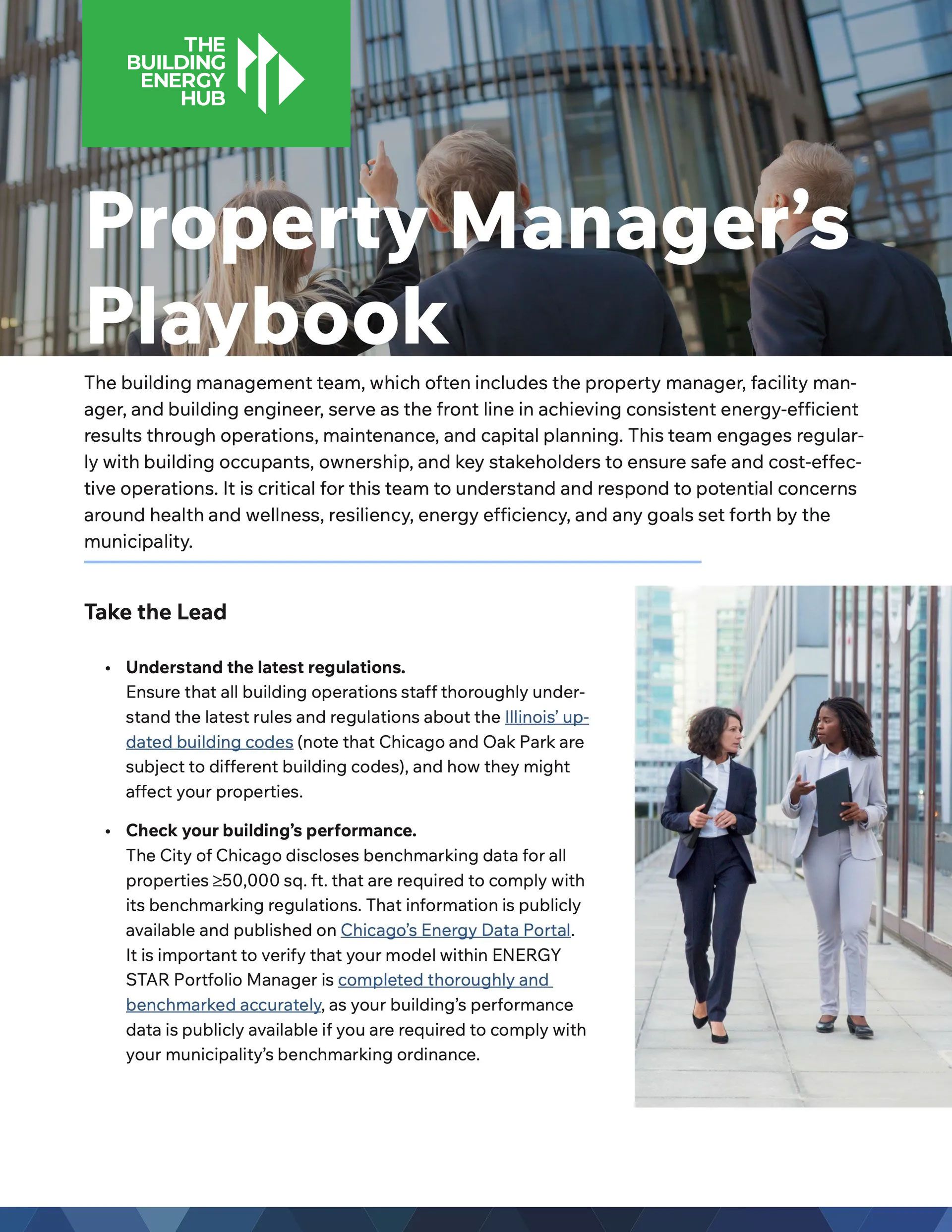Property Manager's Playbook
“The person who manages your building has a bigger impact on your health than your doctor.”
–
Dr. Joseph Allen, Deputy Director of the Harvard Education and Research Center for Occupational Safety & Health
The building management team, which often includes the property manager, facility manager, and building engineer, serve as the front line in achieving consistent energy-efficient results through operations, maintenance, and capital planning.
This team engages regularly with building occupants, ownership, and key stakeholders to ensure safe and cost-effective operations.
It is critical for this team to understand and respond to potential concerns around health and wellness, resiliency, energy efficiency, and any goals set forth by the municipality.
Take the Lead
- Understand the latest regulations.
Ensure that all building operations staff thoroughly understand the latest rules and regulations about the Illinois’ updated building codes (note that Chicago and Oak Park are subject to different building codes), and how they might affect your properties. - Check your building’s performance.
The City of Chicago discloses benchmarking data for all properties ≥50,000 sq. ft. that are required to comply with its benchmarking regulations. That information is publicly available and published on Chicago’s Energy Data Portal. It is important to verify that your model within ENERGY STAR Portfolio Manager is completed thoroughly and benchmarked accurately, as your building’s performance data is publicly available if you are required to comply with your municipality’s benchmarking ordinance.

Communicate & Plan
- Engage the building owner.
Ensure that the building’s ownership team understands how their building is performing and is involved in the development of short and long-term strategies for energy use reduction. - Set a shared goal.
Facilitate collaborative conversations with the building’s ownership and operations teams to determine the building’s performance goals. Ensure that all internal stakeholders and decision makers agree to the goals being set and that they are committed to executing a plan to achieve them. - Perform an energy audit.
Hire an expert to conduct an energy audit, if one has not been completed within the past five years, to identify possible areas for performance improvement. This should include analysis of energy demand, consumption, and historical use patterns, covering base building systems as well as tenant usage when applicable. Ensure the audit team focuses on both operational strategies as well as potential capital improvements with ROI against a determined baseline. ComEd’s Energy Efficiency program can help reduce energy use for commercial, institutional and public buildings and ComEd and People’s Gas offer similar services through the Multi-Family Comprehensive Energy Efficiency Program. - Develop a strategic energy management plan (SEMP).
A strategic energy management plan should focus on optimizing existing equipment, identifying low- and no-cost energy conservation measures that can be immediately implemented, and energy-focused capital planning for larger retrofits and systems replacements.

Improve your Operations
- Implement the SEMP.
ENERGY STAR provides guidance on implementing a SEMP. Opportunities may include, but are not limited to: - Track real-time energy use to understand energy use after hours, demand and consumption patterns, equipment and system runtimes, and opportunities to reduce base load usage.
- Optimize equipment runtime seasonally, weekly, and daily, with a focus on building recovery during start-up relevant to outside conditions (“operator-based optimal start and stop”).
- Assess ventilation systems and sequences (independent of mechanical cooling) and the use of outdoor air requiring conditioning.
- Narrow the window of simultaneous heating and cooling through control sequences adjustments.
- Leverage and maximize use of economizers designed into the system (i.e. air-side or water-side free cooling during favorable weather conditions).
- Conduct a nighttime walkthrough to see what equipment, lights, or systems are running while the building is vacant.
- Partner with a building automation system controls contractor to identify more advanced controls strategies, such as discharge and static air reset controls based on space conditions.
- Integrate a continuous commissioning plan (in house, if possible) into the preventive maintenance program.
- Determine the feasibility of using variable frequency drives on electric motors, such as pumps and fans, to limit energy consumption.
- Review options for LED lighting retrofits, including public and back-of-house areas.
- Inspect the building envelope and entryways regularly for leaks, cracks, or degradation of materials.
- Track the improvements.
Upon developing a SEMP and completing the low- or no-cost operational improvements, be sure to track energy conservation measure (ECM) implementation and energy use against the baseline performance.


Communicate with Building Occupants
- Engage your tenants.
Communicating with your tenants about how their actions impact building performance and energy use is imperative, especially given their influence depending on building type. This endeavor can be challenging with commercial tenants and even more so for residential buildings with either owned or rented units. The Green Lease Library, a resource provided by the Institute for Market Transformation and the U.S. Department of Energy’s Better Buildings Alliance, offers numerous resources including how to institute high-performance leases. The team can also get recognized for integrating this approach into practice through the Green Lease Leaders recognition program.
- Identify an “energy champion.”
Identify a champion for each tenant who is willing to support the building in achieving performance goals. This person should promote conservation efforts among their peers and represent the tenant in energy-focused conversations with building management. - Identify opportunities for tenants.
Help your tenants understand what actions they can take and support additional measures in their space by explaining available options or connecting them with available funding opportunities and programs.
Identify Opportunities for Capital Improvements
- Analyze current improvement plans.
Determine if there is potential alignment of performance goals, existing or planned building upgrades, as well as opportunities presented in the energy audit report. - Develop a capital improvement plan.
Alongside the building’s ownership team, develop a capital improvement plan that addresses building operations from a financial and energy use perspective. Additionally, consider how aging equipment and existing infrastructure may help or hinder adaptation to market trends such as building automation, system electrification, resiliency to power emergencies, and rising tenant demand for health and wellness measures. Improvements should provide an advantageous ROI for easier ownership approval, as well as utilize available incentives and financial programs. It is key that the ownership team understands the Performance Requirements, and potential penalties for non-compliance.
This resource is based upon content originally developed by the Institute for Market Transformation in collaboration with DPR Construction for the Building Innovation Hub, with funding and support provided by the District of Columbia’s Department of Energy & Environment.



